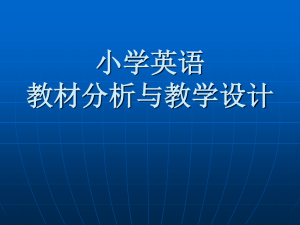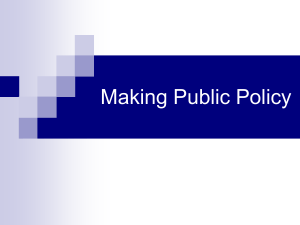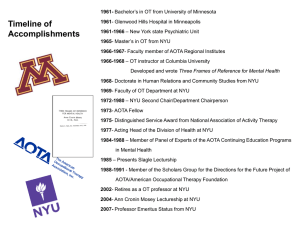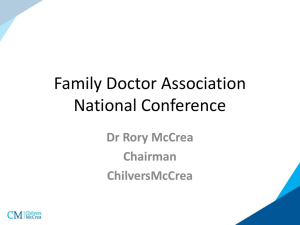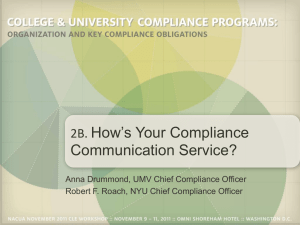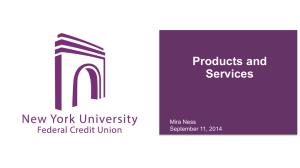Case Study
advertisement
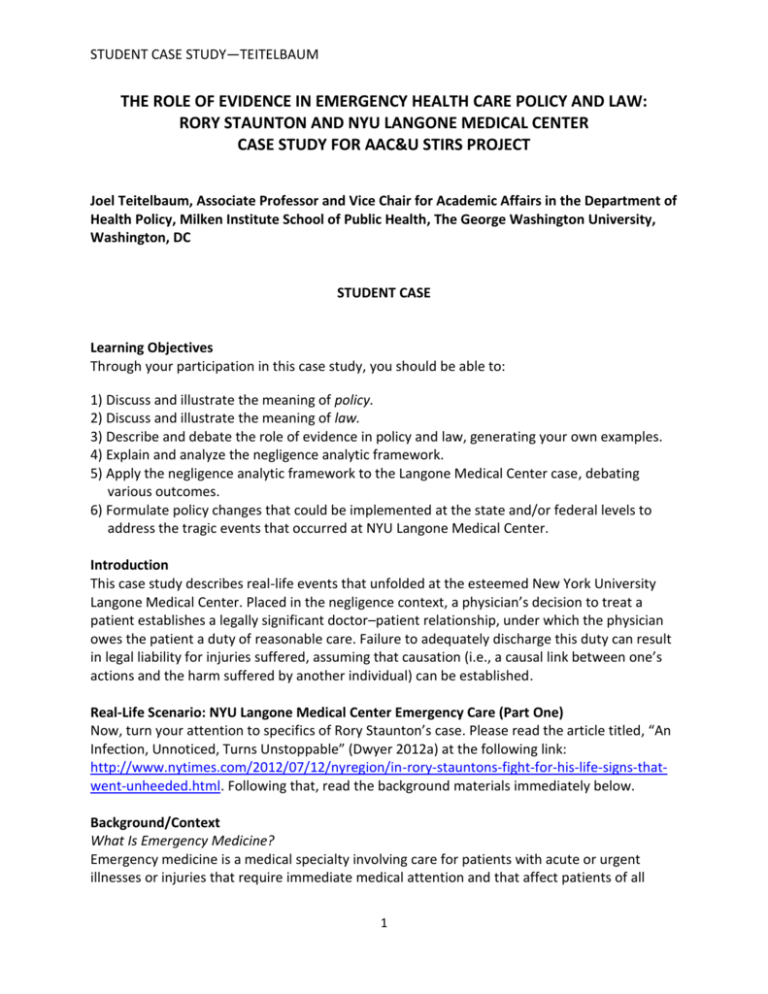
STUDENT CASE STUDY—TEITELBAUM THE ROLE OF EVIDENCE IN EMERGENCY HEALTH CARE POLICY AND LAW: RORY STAUNTON AND NYU LANGONE MEDICAL CENTER CASE STUDY FOR AAC&U STIRS PROJECT Joel Teitelbaum, Associate Professor and Vice Chair for Academic Affairs in the Department of Health Policy, Milken Institute School of Public Health, The George Washington University, Washington, DC STUDENT CASE Learning Objectives Through your participation in this case study, you should be able to: 1) Discuss and illustrate the meaning of policy. 2) Discuss and illustrate the meaning of law. 3) Describe and debate the role of evidence in policy and law, generating your own examples. 4) Explain and analyze the negligence analytic framework. 5) Apply the negligence analytic framework to the Langone Medical Center case, debating various outcomes. 6) Formulate policy changes that could be implemented at the state and/or federal levels to address the tragic events that occurred at NYU Langone Medical Center. Introduction This case study describes real-life events that unfolded at the esteemed New York University Langone Medical Center. Placed in the negligence context, a physician’s decision to treat a patient establishes a legally significant doctor–patient relationship, under which the physician owes the patient a duty of reasonable care. Failure to adequately discharge this duty can result in legal liability for injuries suffered, assuming that causation (i.e., a causal link between one’s actions and the harm suffered by another individual) can be established. Real-Life Scenario: NYU Langone Medical Center Emergency Care (Part One) Now, turn your attention to specifics of Rory Staunton’s case. Please read the article titled, “An Infection, Unnoticed, Turns Unstoppable” (Dwyer 2012a) at the following link: http://www.nytimes.com/2012/07/12/nyregion/in-rory-stauntons-fight-for-his-life-signs-thatwent-unheeded.html. Following that, read the background materials immediately below. Background/Context What Is Emergency Medicine? Emergency medicine is a medical specialty involving care for patients with acute or urgent illnesses or injuries that require immediate medical attention and that affect patients of all 1 STUDENT CASE STUDY—TEITELBAUM ages. Emergency care providers do not engage in long-term care; rather, they diagnose and treat emergent conditions in order to stabilize patients for further needed care. In fact, the only federal law that provides equal health care access to all individuals regardless of their insurance status, socioeconomic status, gender, age, or any other descriptor, is focused solely on stabilizing patients in need of emergency medical care. The law—called the Emergency Medical Treatment and Labor Act, or EMTALA—is enormously important to the emergency care of all individuals, but particularly so for those who are uninsured, who before passage of EMTALA were routinely denied life-saving medical care. What Is Policy? There is no single correct definition of policy. Consider just a few definitions, all of which are accepted as valid: Authoritative decisions made in the legislative, executive, or judicial branches of government that are intended to direct or influence the actions, behaviors, and decisions of others. (Longest 1998, 243) Authoritative decisions and guidelines that direct human behavior toward specific goals either in the private or the public sector. (Hanley 1998, 125) Policy . . . evolves from a many-faceted social process involving multiple actors engaged in assembling, interpreting, and debating what evidence is relevant to the policy choice at hand, and then, perhaps, using that evidence to claim that a particular policy choice is better than its alternatives. This process is best understood as a form of policy argument or practical reasoning that is persuasive with respect to the benefit or harm of policy actions. (The National Academies Press 2012) The differences in these definitions raise several questions. First, do private actors make policy or is policymaking an activity for the government only? Without question, governments at all levels are key players in any policy field, and it is certainly true that decisions by government entities represent public policy. However, decisions by private employers, influential individuals, and major foundations can all influence policy and policymaking. Second, why do two of the definitions refer to “authoritative” decision making? This stems from the fact that irrespective of whether a policymaker is a public institution or private figure, it is necessary that policy decisions are made by those with the power to implement the decision. Third, are all decisions by authoritative public entities and private interests worth considering as policymaking? The answer is no: The key issue to determining whether a decision represents a policy is whether the issue being considered goes beyond an individual concern and affects the greater good. Thus when determining whether policymaking is underway, attention must be paid not only to the decision maker, but also to the type of decision being made. 2 STUDENT CASE STUDY—TEITELBAUM What Is the Role of Evidence in Policymaking? A full exploration of the role of evidence in policymaking—a role that is truly monumental—is well beyond the scope of this case. Indeed, in the public policy sphere, evidence is used in the formulation, implementation, and interpretation of policy across branches of government: witness the legislative history for the Affordable Care Act (legislative branch), rulemaking aimed at implementing the Medicaid program (administrative branch), and a court determining when there is sufficient evidence that a new national standard of care has emerged (judicial branch). (Bear in mind, however, that notwithstanding the importance of evidence to sound policymaking, sometimes policies are made based on criteria unrelated to evidentiary reasons; public opinion, political considerations, personal preferences, and more can all color policy decisions regardless of what evidence would otherwise dictate.) For now, it is enough to briefly consider just a handful of the elements of policy research (Wilensky 2004) that help inform sound policy decisions. For example, policy researchers ask the following questions when conducting policy research: 1. What are the implications of implementing a particular policy, including its cost? 2. How clear can researchers/analysts be about any potential unintended consequences of implementing a particular a policy? 3. What are the different approaches to address a specific policy issue? 4. With regard to various alternatives, what information/data will be needed in order to answer questions about which approach to take? 5. Can the research evidence be presented in a way that is understandable to lay people? What Is Law? Law is the main tool by which we organize society. It is the method by which we govern our relationships with one another, our government, and society at large. A society as sprawling and complex as ours needs formal, enforceable rules of law to provide a measure of control and to alert all members of society—individuals, private industry, governments, etc.—what is expected of them, and what is prohibited. The most obvious way the law serves the organizing function and regulates the many kinds of relationships in society is to establish legal rights (i.e., powers or privileges that have been guaranteed to an individual under the law, as opposed to something that is claimed as an interest or something that is a matter of governmental discretion), and to create the institutions necessary to enforce those rights (because a person’s ability to secure a remedy when a legal right is infringed goes to the very heart of what it means to be “entitled” to something). 3 STUDENT CASE STUDY—TEITELBAUM As with the term policy, there are several plausible definitions of “the law,” and thus no single correct way to define it. Here’s how Black’s Law Dictionary, considered the most definitive legal dictionary, defines law: 1. The regime that orders human activities and relations through systematic application of the force of politically organized society, or through social pressure, backed by force, in such a society…. 2. The aggregate of legislation, judicial precedents, and accepted legal principles; the body of authoritative grounds of judicial and administrative action; esp., the body of rules, standards, and principles that the courts of a particular jurisdiction apply in deciding controversies brought before them. (Garner 2009) Reading between the lines, “the law” essentially amounts to a legal system: the laws themselves—the words on a page—had to be drafted, and they need to be implemented and enforced. Note that the conceptualization of law as a system squares with the idea that the primary function of law is to organize society, since there must by necessity be a sizeable system in place if law is going to play this role. Finally, note that law is the mechanism through which public policy is implemented. Indeed, law is inherent to the expression of public policy: major changes to policy often demand the creation, amendment, or rescission of laws. Thus, because law is an indispensable component of public policy, students studying across a range of disciplines and subject areas should learn about the law, legal process, and legal concepts. What Is the Role of Evidence in Law? In a legal context, evidence is concerned with the rules and principles that govern the proof of facts in a legal proceeding. Rules of evidence determine what evidence can be considered by the judge and/or jury in reaching decision; the importance to be placed on certain evidence; and the reliability of evidence. Evidence plays an important role in the administration of justice: unless a jury, judge, and/or court know the facts of a case, how can justice hope to be achieved? The legal rules of evidence are primarily concerned with five issues: 1. Is the evidence presented relevant? To be considered, evidence must show, directly or indirectly, that a fact in dispute did or did not exist. 2. Can facts be established without evidence? For example, was there an admission by one party that obviates the need for evidence? 3. How should evidence be presented to the court? For example, what is the proper method by which to perform cross-examination of a witness? 4 STUDENT CASE STUDY—TEITELBAUM 4. Who has the burden of proof to produce evidence? Generally (though not always), the party to a lawsuit who seeks to establish liability on the part of another party bears the burden of persuading a judge or jury the court of his allegations. 5. What are the proper roles of those who play parts during the course of a trial? For example, juries are meant to determine facts, while judges make determinations of law. Analytic Framework: Negligence Law Like many disciplines, the law uses analytic frameworks to evaluate evidence and guide the application of existing standards and principles and to help navigate future policy and legal quandaries. One such framework, used in conjunction with the evidentiary principles discussed above, is applied to determine whether individuals and corporations acted negligently (though unintentionally) in harming another individual, which means they failed to act in a way that a reasonably prudent person would under similar circumstances. Negligence law concerns itself with regulating the behaviors and relationships of private parties in society. To commit negligence is to commit what is known as a tort—a term that derives from the Latin word for “twisted” and that applies to situations where the actions of an individual or entity “twists away” from being reasonable and results in harm to others. Proving negligence is not easy; an individual seeking to hold another person or entity responsible under this theory of liability must demonstrate four things: 1. a duty to act in a certain way, or to refrain from acting in a certain way; 2. a breach of that duty by the defendant; 3. a measurable harm (for example, physical pain, emotional suffering, destruction of property); and 4. a causal link (i.e., causation) between the defendant’s breach and the injury suffered. In many cases, the element of “causation” is the hardest to prove, and thus the most critical component of a negligence lawsuit. For more information in causation, read sections nos. 2 and 3 of Causation in the Law. Langone Medical Center’s Normative Practices The New York Times article describing Rory Stauton’s visit to Langone Medical Center does not describe what, if any, specific rules the hospital had in place that guided medical care providers in handling situations where a patient’s laboratory results were completed post-discharge. However, it is instructive that at the time Langone participated in the Stop Sepsis Collaborative, an initiative focused on the early identification and treatment of sepsis in hospital emergency departments (you can read about the Collaborative at http://www.uhfnyc.org/initiatives/quality_improvement/STOP_Sepsis). Among other things, the Collaborative develops model protocols and checklists geared toward case identification and rapid treatment of sepsis. Consider this fact as you work through the questions below. 5 STUDENT CASE STUDY—TEITELBAUM Key Questions—Part One 1) What do you think Rory’s case is evidence of: Hospital negligence? A procedural flaw in this particular hospital, with no legal significance? Simple human error, with no legal significance? Something else? Explain your thinking. 2) Depending on your answer from Question 1, do you believe something should change as a result? If so, should the change be in hospital policy or in law? Explain your thinking. 3) Why do you believe the facts played out this way? In other words, why do you think a patient with alarming blood work results was not contacted by NYU Langone? For example, substandard hospital policy? Mere custom? Clinician burnout? Something else? 4) Many people (including many physicians) contend that the facts underlying the Rory Staunton case are anything but unique, and that many hospitals every day are presented with kids who have similar laboratory results, similar vital signs, and nothing more dangerous than viral gastroenteritis—commonly known as the stomach flu. Assuming that the Langone clinicians believed that this was Rory’s diagnosis, too, what is your response? 5) What do you think the law’s (i.e., society’s) expectation should be when it comes to judging how health care providers differentiate among, and make sense of medical evidence, particularly in complex, real-time, time-sensitive situations? Real-Life Scenario: NYU Langone Medical Center Emergency Care (Part Two) Nearly four months after Rory Staunton’s death, NYU Langone announced changes to its discharge procedures. Please read the article titled, “After Boy’s Death, Hospital Alters Discharging Procedures” (Dwyer 2012b) at the following link: http://www.nytimes.com/2012/07/19/nyregion/after-rory-stauntons-death-hospital-altersdischarge-procedures.html, and then consider the questions below. Key Questions—Part Two 1) What do you think is the medical significance of NYU Langone’s policy revision? 2) What do you think is the legal significance of NYU Langone’s policy revision? 3) If you were Rory Staunton’s parents, would you pursue legal action against NYU Langone notwithstanding the new discharge policy? Why or why not? Consider the Source (Part Three) At the heart of this Student Case are two news articles from the New York Times. Does the source of the information color your thinking about the facts? If so, in what way? Do you think you have all—or at least nearly all—of the facts needed to provide informed answers to the questions above? If not, do you think that longer-form, investigational articles would have done 6 STUDENT CASE STUDY—TEITELBAUM the trick? Or do you doubt that complex health care decisions and their consequences can be consumed and understood by the public (read: lay people) in this fashion? Lastly, do you believe that, on balance, this type of story can lead to effective policy change? If so, in what ways? Explain your thinking. References Dwyer, J. 2012a. “An Infection, Unnoticed, Turns Unstoppable.” New York Times, July 12. http://www.nytimes.com/2012/07/12/nyregion/in-rory-stauntons-fight-for-his-life-signs-thatwent-unheeded.html?_r=2&ref=nyregion&pagewanted=all. Dwyer, J. 2012b. “After Boy’s Death, Hospital Alters Discharging Procedures.” New York Times, July 19. http://www.nytimes.com/2012/07/19/nyregion/after-rory-stauntons-death-hospitalalters-discharge-procedures.html. Garner, B. A., ed. 2009. Black's Law Dictionary. 9th ed. Eagan, MN: West Publishing. Hanley, B. E. 1998. “Policy Development and Analysis.” In Policy and Politics in Nursing and Health Care, 3rd ed., edited by J. K. Leavitt, D. J. Mason, and M. W. Chaffee. Philadelphia: WB Saunders. Longest, B. B., Jr. 1998. Health Policy Making in the United States. 2nd ed. Chicago: Health Administration Press. Teitelbaum, J., and S. Wilensky. 2013. Essentials of Health Policy and Law. 2nd ed. Burlington, MA: Jones and Bartlett Learning. The National Academies Press. 2012. Using Science as Evidence in Public Policy. Washington, DC: The National Academies Press. Wilensky, G. 2004. “Framing the Public Policy Questions: Financial Incentives for Efficiency and Effectiveness.” Medical Care Research and Review, 61: 3 (September Supplement). For Further Reading/Viewing Sepsis Resources Surviving Sepsis Campaign Greater New York Hospital Association- Stop Sepsis Collaborative Additional Resources Death of a Boy Prompts New Medical Efforts Nationwide 7 STUDENT CASE STUDY—TEITELBAUM Reaction to Column About a Boy Who Dies The National Working Group on Evidence-Based Healthcare Emergency Department Adult Sepsis Protocol- Dartmouth-Hitchcock Medical Center Rory Staunton's Death Leads to New Statewide Sepsis Procedures (Video)EverydayHealth To see medical documents related to the Rory Staunton case, go to: http://www.nytimes.com/interactive/2012/07/11/nyregion/medical-documents-indepsis-death.html?ref=nyregion About the Author Joel Teitelbaum is associate professor and vice chair for academic affairs in the Department of Health Policy, and the director of the Hirsh Health Law and Policy Program, at Milken Institute School of Public Health at George Washington (GW) University in Washington, DC. He also serves as co-principal investigator of the National Center for Medical–Legal Partnership at GW. Professor Teitelbaum has taught graduate courses on health care law, health care civil rights, public health law, minority health policy, and long-term care law and policy, and an undergraduate survey course on health law. In 2009, he became the first member of the GW School of Public Health and Health Services (SPHHS) faculty to win the university-wide Bender Teaching Award, and he also received an SPHHS Excellence in Teaching Award for his graduate coursework. He has authored or co-authored many articles, book chapters, policy papers, and reports on civil rights issues in health care, insurance law and policy, health reform and its implementation, and behavioral health care quality, and he is the lead author of Essentials of Health Policy and Law, Second Edition (2013), an introductory textbook, and of Essential Readings in Health Policy and Law (2009), a companion to the textbook. 8
